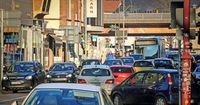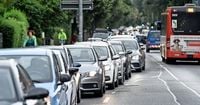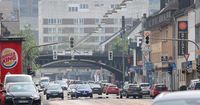On October 26, 2025, drivers across Germany faced a familiar but frustrating reality: traffic jams and delays, stretching from Celle in the north to Remscheid in the west, and all the way to the Dahme-Spreewald region near Berlin. According to regional news outlets including CZ, Tageblatt, MAZ, OP, and RGA, the day was marked by widespread slowdowns on highways and main roads, largely due to new construction sites and a spate of accidents that caught many motorists off guard. If you were hoping for a smooth Sunday drive, you were likely in for a surprise.
In Celle and its surroundings, the traffic situation was especially sluggish. As reported by CZ, major delays were observed on Bundesstraße 3 (B3) heading south toward Hannover and Soltau, as well as on Bundesstraße 214 (B214) toward Braunschweig and Schwarmstedt, and Bundesstraße 191 (B191) in the direction of Uelzen. The Wilhelm-Heinichen-Ring in Celle itself became a particular headache, with ongoing construction forcing drivers to seek alternative routes. "Please take care of other road users," CZ reminded its readers—a refrain echoed by other regional publications.
But Celle wasn’t alone. In Göttingen and the wider Eichsfeld region, Tageblatt described a similar scene. Here, the highways A7 and A38, as well as Bundesstraßen B3, B241, B247, B248, and B446, were plagued by slow-moving traffic. The causes were familiar: new construction projects and unexpected accidents. Local authorities also announced mobile speed cameras for the week ahead in Göttingen and Northeim districts, hoping to curb risky driving behaviors that often contribute to these jams. The city’s accident-prone hotspots were also highlighted, with Tageblatt noting that Göttingen sees numerous crashes each year—some with tragic, even fatal, consequences.
Further east, the Dahme-Spreewald region (covering cities like Königs Wusterhausen, Schönefeld, Lübben (Spreewald), and Zeuthen) found itself in the grip of similar congestion. According to MAZ, traffic was especially slow on the A10 (both the southern and eastern rings), A12, A13, and A113—the latter serving as the main access road to Berlin Brandenburg Airport (BER). Bundesstraßen in the area, including the B101, B96, B102, B115, B179, and B246, also saw significant delays. Notably, a larger accident on the A12 between Dreieck Spreeau and the Polish border added to the day’s woes, impacting not just local commuters but also those traveling longer distances across the region.
Marburg and the Marburg-Biedenkopf district were not spared either. OP reported that the region’s main arteries—Bundesstraßen B3, B62, B236, B252, B253, B255, B453, and B454—were all affected by a combination of construction and accidents. The cumulative effect was a day where, no matter which direction you turned, you were likely to be stuck behind a long line of brake lights. For many residents, these delays are becoming an all-too-regular part of daily life.
Perhaps nowhere was the congestion more acute than in Remscheid and its neighboring cities of Wermelskirchen, Solingen, and Wuppertal. The RGA painted a picture of a region beset by gridlock, especially on the A1 and A46 highways. The A1, particularly between Cologne and Dortmund, racked up an astonishing 6,500 hours of traffic jams, making it one of the most congested stretches of road in the entire country. The A46, connecting Düsseldorf and Wuppertal, was ranked the sixth most congested route in North Rhine-Westphalia in 2023. Ongoing reconstruction at the Autobahnkreuz Wuppertal-Nord—a project expected to last the next decade—only compounded the problem. Key Bundesstraßen (B51, B51n, B229, B237, B483) and state roads (L74, L81, L101, L418) were also flagged as trouble spots, with frequent bottlenecks, especially near major junctions and industrial zones.
So, what ties these stories together? A single thread runs through each region’s reporting: the reliance on real-time traffic data provided by TomTom. As each newspaper explained, TomTom’s system collects GPS data from millions of devices, including around 80 million mobile phones and numerous official road sensors. This information is updated every five minutes, giving drivers—and newsrooms—a timely snapshot of where the worst slowdowns are occurring. CZ emphasized that this partnership enables them to quickly inform readers of new incidents, while MAZ and Tageblatt noted that other navigation providers, such as Google Maps, Apple Maps, and Garmin, also play a role in keeping the public updated.
But even the best data can’t move traffic by itself. The real-world impact of these jams is felt by everyone from daily commuters to occasional travelers. For truck drivers hauling goods across the country, every hour lost in traffic translates to missed deadlines and increased costs. For families headed out for a weekend excursion, a simple journey can become a test of patience. And for emergency services, congestion can mean the difference between life and death when minutes count.
Local authorities are taking steps to address these challenges, but the sheer scale of roadworks and the unpredictability of accidents make a quick fix elusive. In Göttingen, for example, the deployment of mobile speed cameras is intended to reduce risky driving at known accident hotspots. In Remscheid, the massive overhaul of the Autobahnkreuz Wuppertal-Nord is seen as a long-term investment in smoother traffic flow, even if it means years of short-term pain. Meanwhile, news outlets continue to urge drivers to be considerate: "Please always show consideration for other road users," was the universal message across all reports.
For now, the best advice remains simple: plan ahead, check traffic updates before you travel, and pack a little extra patience. As Germany’s roads continue to evolve—with new construction projects, changing traffic patterns, and the ever-present risk of accidents—real-time information is more valuable than ever. But as anyone stuck in Sunday’s jams can attest, sometimes the only thing you can do is wait it out—and hope tomorrow’s commute is just a little bit smoother.



